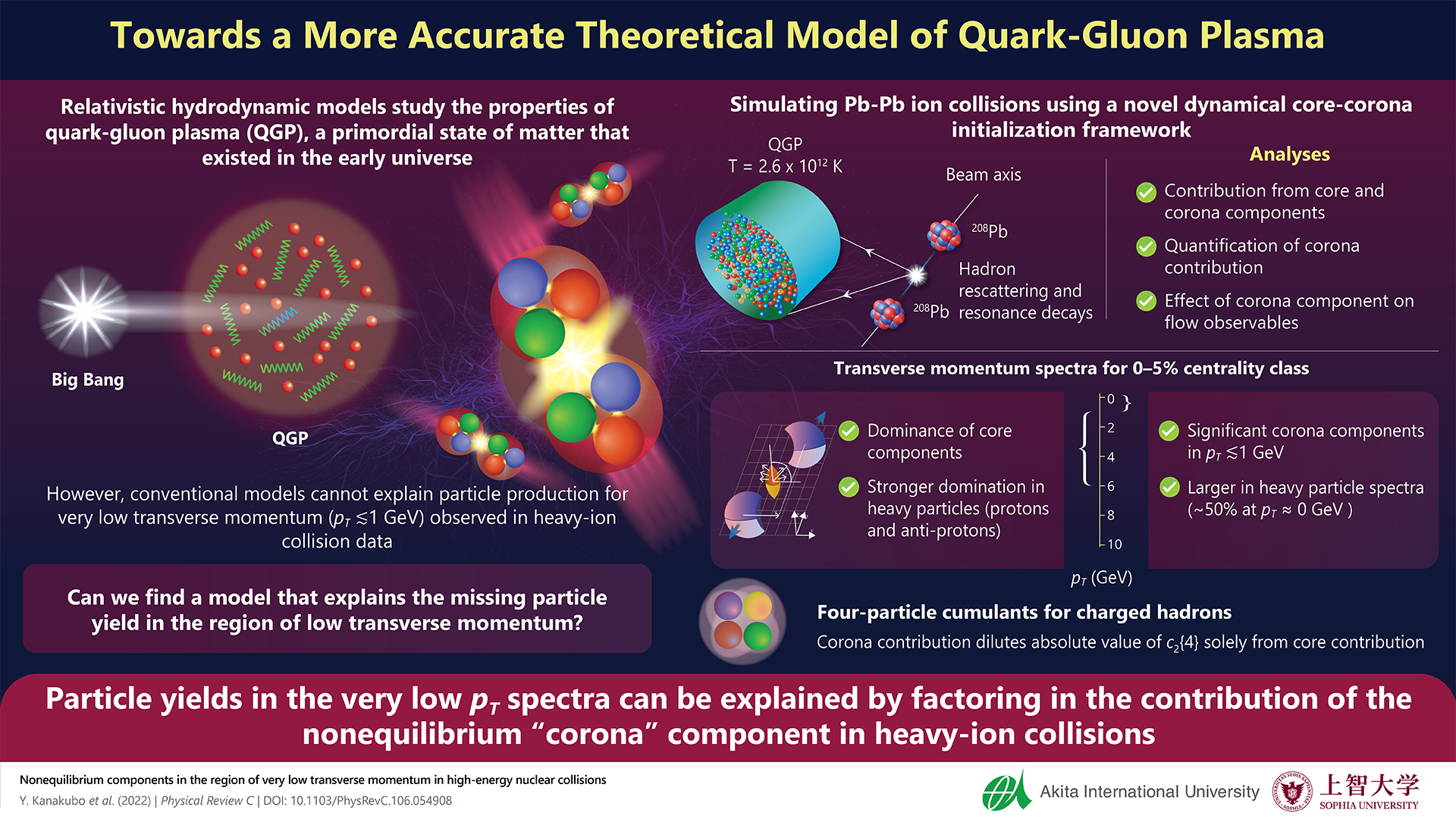A new theoretical framework has been given by Japanese researchers for explaining the quark-gluon plasma which better matches experimental data.

Image Credit: Sophia University
With the help of relativistic hydrodynamical models, the properties of quark-gluon plasma (QGP), the primordial form of matter in the early universe, are explained. However, such models tend to forecast low particle yields in the low transverse momentum region, which contradicts experimental data.
For this difference to be addressed, scientists from Japan have suggested a novel framework depending on a so-called “core-corona” picture of QGP. This hypothesizes that the corona component might add up to the high particle yields that have been noted.
A study performed in fundamental science has disclosed the presence of quark-gluon plasma (QGP—a newly determined state of matter) as the constituent of the early universe. Known to have been present a microsecond after the formation of the Big Bang, the QGP, fundamentally a soup of quarks and gluons, cooled down with time to develop hadrons like protons and neutrons— the building blocks of all matter.
One method to reproduce the extreme conditions that existed when QGP existed is via relativistic heavy-ion collisions. In that respect, particle accelerators like the Large Hadron Collider (LHC) and the Relativistic Heavy Ion Collider have promoted the knowledge of QGP with experimental data concerning such collisions.
At the same time, theoretical physicists have applied multistage relativistic hydrodynamic models to describe the data, as the QGP acts very much like an ideal fluid.
But, there has been a severe lingering disagreement between such models and data in the region of low transverse momentum, where both the traditional and hybrid models have failed to describe the particle yields noted in the experiments.
Against this backdrop, a research group from Japan, headed by theoretical physicist Professor Tetsufumi Hirano of Sophia University, carried out an investigation to consider the missing particle yields in the relativistic hydrodynamic models.
In their recent study, they suggested a novel “dynamical core-corona initialization framework” to fully explain high-energy nuclear collisions.
Their study outcomes were reported in the journal Physics Review C on November 18th, 2022, and involved contributions from Dr. Yuuka Kanakubo, a doctoral student at Sophia University, (present affiliation: postdoctoral research fellow at the University of Jyväskylä, Finland) and Assistant Professor Yasuki Tachibana from Akita International University, Japan.
To find a mechanism that can account for the discrepancy between theoretical modeling and experimental data, we used a dynamical core-corona initialization (DCCI2) framework in which the particles generated during high-energy nuclear collisions are described using two components: the core, or equilibrated matter, and the corona, or nonequilibrated matter.
Tetsufumi Hirano, Theoretical Physicist Professor, Sophia University
Hirano added, “This picture allows us to examine the contributions of the core and corona components towards hadron production in the low transverse momentum region.”
The scientists performed heavy-ion Pb-Pb collision simulations on PYTHIA (a computer simulation program) at an energy of 2.76 TeV to test their DCCI2 framework.
Dynamical initialization of the QGP fluids enabled the isolation of core and corona components, which were made to experience hadronization through “switching hypersurface” and “string fragmentation,” respectively. Further, such hadrons were subjected to resonance decays to achieve the transverse momentum (pT) spectra.
We switched off the hadronic scatterings and performed only resonance decays to see a breakdown of the total yield into core and corona components, as hadronic scatterings mix up the two components in the late stage of reaction.
Dr. Yuuka Kanakubo, Doctoral Student, Sophia University
Further, the scientists analyzed the fraction of core and corona components in the pT spectra of charged kaons, charged pions, and protons and antiprotons for collisions at 2.76 TeV.
Following that, they made a comparison of such spectra with that obtained from experimental data (from the ALICE detector at LHC for Pb-Pb collisions at 2.76 TeV) to measure the contributions from corona components. Eventually, they analyzed the effects of contributions from corona components on the flow variables.
The researchers discovered a comparative increase in corona contributions in the spectral region of roughly 1 GeV for both 0–5% and 40–60% centrality classes. While this was the case for all the hadrons, they found nearly 50% corona contribution to particle production in the spectra of antiprotons and protons in the region of very low pT (≈ 0 GeV).
Then, the outcomes obtained from full DCCI2 simulations showed improved agreement with the ALICE experimental data than when only core components with hadronic scatterings (which ignore corona components) were compared.
The corona contribution was seen to be responsible for diluting the four-particle cumulants (a flow observable) achieved purely from core contributions, showing more permutations of particles along with the corona contribution.
These findings imply that the nonequilibrium corona components contribute to particle production in the region of very low transverse spectra.
Tetsufumi Hirano, Theoretical Physicist Professor, Sophia University
Hirano added, “This explains the missing yields in hydrodynamic models, which extract only the equilibrated core components from experimental data. This clearly shows that it is necessary to extract the nonequilibrated components as well for a more precise understanding of the properties of QGP.”
Journal Reference
Kanakubo, Y., et al. (2022) Nonequilibrium components in the region of very low transverse momentum in high-energy nuclear collisions. Physical Review C. doi.org/10.1103/PhysRevC.106.054908.